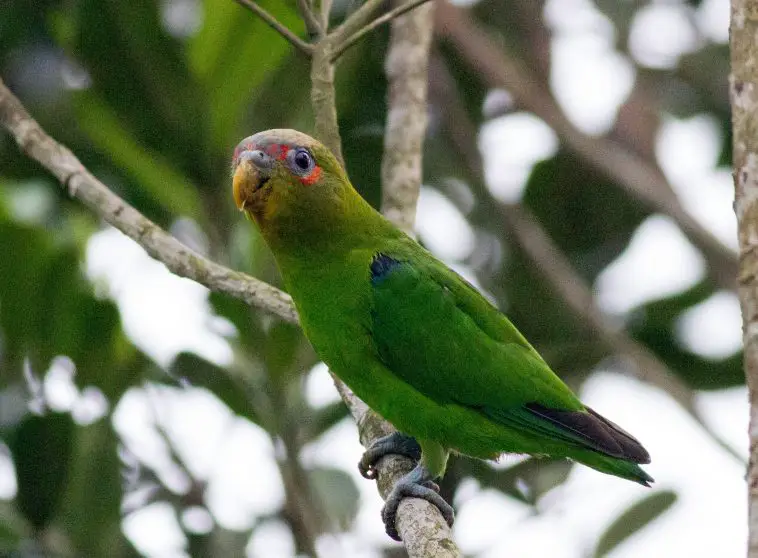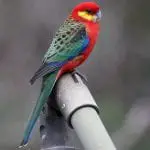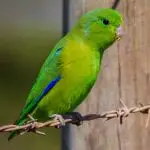Scientific Facts
| Common Name | Blue-fronted Parrotlet |
| Scientific Name | Touit Dilectissimus |
| Life Span | 10-15 years |
| Size | 5.9-6.7 inches |
| Habitat | Primary forests |
| Country of Origin | -Eastern Panama to northern Colombia, western Venezuela -South to southwestern Ecuador |
Physical Description
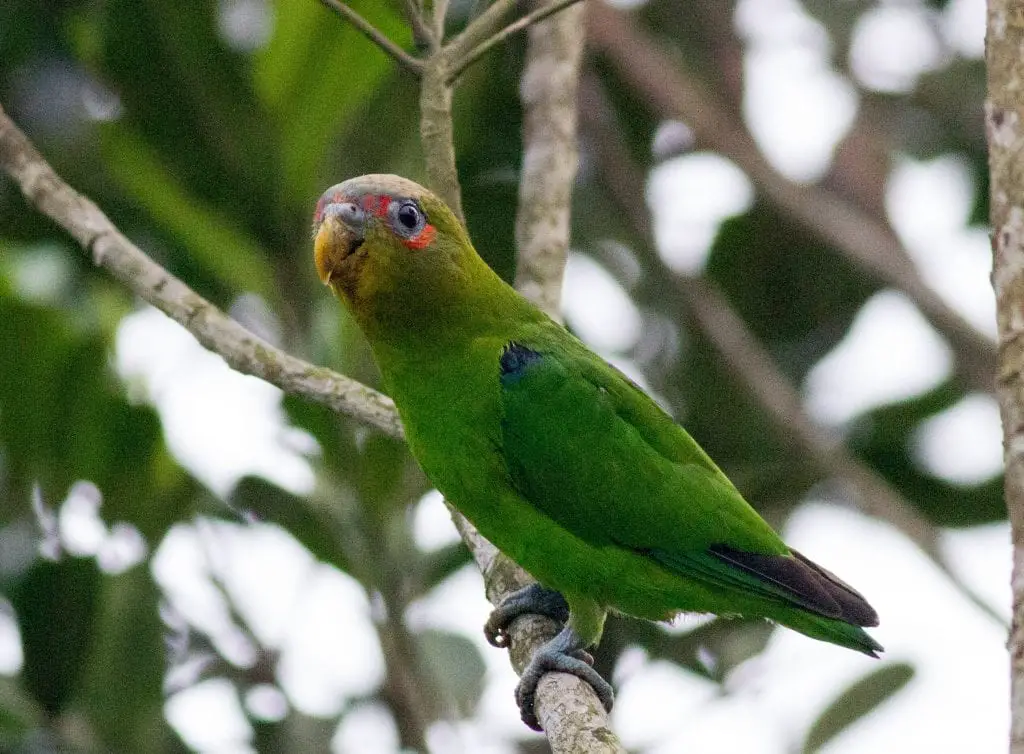
The Blue-fronted Parrotlets are mainly green, with a common round pointed tail. They have an average size of 5.9 to 6.7 inches, counting in their short tails. Their weight is around 65 grams. The eye-ring is dull bluish, and the surrounding area of the eye has red patches. The irises are brown. The underwing coverts are yellow. The center tail-feathers are black with a base of green. The exterior tail-feathers are greenish-yellow with tips of black. The upper surface of the wing has red outer coverts, although more broadly in male parrotlets. Their abdomen and breast are yellowish-green. They have a thin red band in the forehead, lores, and lines under the eyes. The feathers underneath the forecrown and red eye-stripe, as well as the upper cheeks, are pale blue. The nape and crown have a bronze shade. The lesser wing-coverts, bend of the wing, interior primary wing feathers, outer median-coverts, and end of wing are red. Both the primary and secondary outer wing feathers are black. The flight feathers have shades of black associated with a green outline in the outer webs. The bill is yellowish horn-hued with a grey edge, and the feet are grey.
Male and Female Blue-fronted Parrotlet look almost similarly, although females have less red in the wing-coverts, and their primary coverts are entirely black.
Lifespan
With proper care, Blue-fronted parrotlets can live as much as 10 to 15 years. There are some cases that some parrotlets even live longer than 15 years. Their life expectancy is still determined by the manner they are raised by their owners.
Eating Habits
Blue-fronted parrotlet feeds on a particular diet. However, do not expect your pet to just eat any new food you introduce. If you are planning to feed your pet with new food, which means that it is something that your pet has never tried before, make sure not to rush your pet. Allow your Blue-fronted parrotlet to adjust to the new menu. You may entice your pet with the new food by showing it is delicious. You may also consider sprinkling its usual food over the new diet.
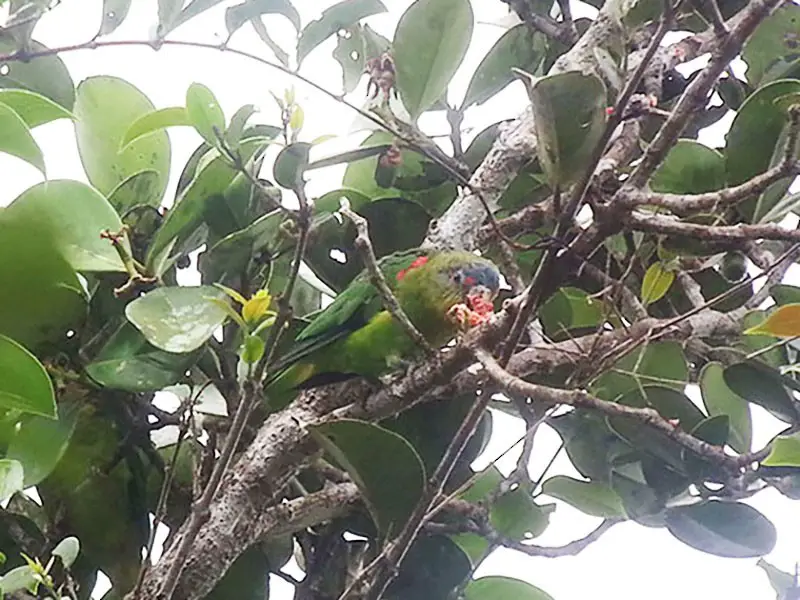
Sleeping Habits
Blue-fronted parrotlets like to get plenty of sleep. Commonly, these creatures need at 10 hours of sleep. They are most likely to fall asleep once the environment gets dark. To help your pet get enough sleep, cover the cage once the pet requires some sleep time. Cover the cage in a similar period every night. This is particularly helpful if your place does not always exhibit much of natural darkness.
Development and Reproduction
Blue-fronted parrotlets nest in tree hollows. Most of the time, these creatures will maximize the deserted tree hole. The female parrotlet shall incubate eggs while the male parrotlet shall take over the responsibility of protecting the nest and providing the chicks and the hen foods.
Chicks fledge at around 5 weeks. Chicks from similar clutch use particular calls and remain to feed one another and play until they become mature and become self-supporting.
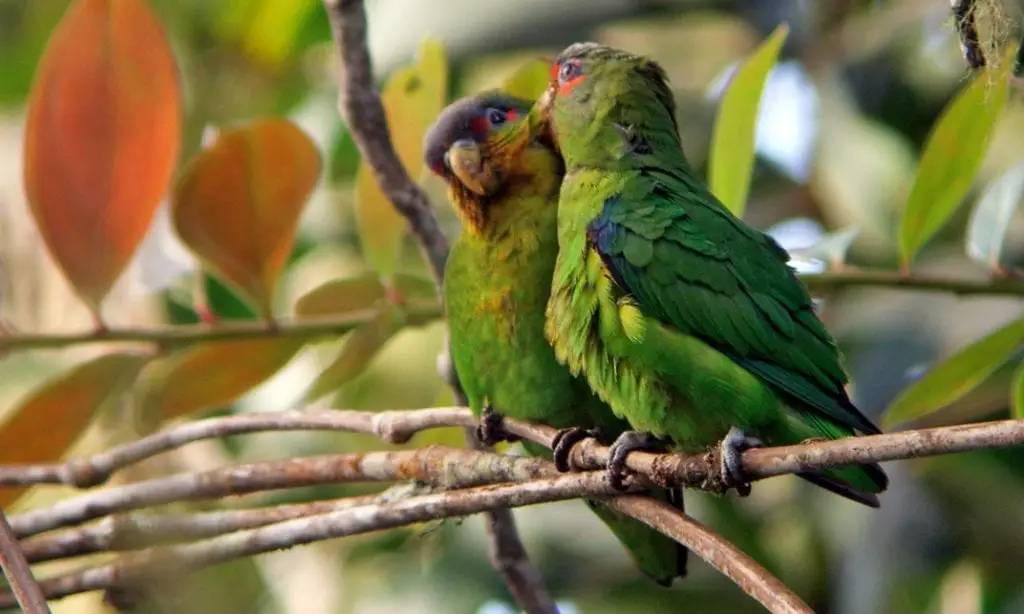
How to Breed
Determining the Sexes
Male and female Blue-fronted parrotlets look almost the same. There is a slight distinction in female parrotlets. However, the best way to determine the sex of your pet is through a DNA test or surgical sexing.
Courtship and Mating
Although Blue-fronted parrotlets are small in size, they do not like breeding in colonies because they tend to become aggressive as they protect their nests. If permitted, many Blue-fronted parrotlets may continuously breed. This is, however, not suggested because this will exhaust the nutrients in females, which may lead to a short lifespan.
Eggs and Incubation
Female Blue-fronted parrotlet may produce eggs ranging from 4 to 8. Every egg is laid with a one-day interval until the completion of the clutch. Once the incubation has begun, the hen will sit on the eggs for 21 to 23 days. Both parents will carry out the responsibilities of feeding the young chicks.
Common Health Problems
Nutritional Deficiencies
The manifestations of an unhealthy diet are different – from the malformation of the beak and feather loss to behavioral issues and a fast decline to death. Blue-fronted parrotlets require daily doses of minerals and vitamins, as well as fatty acids, protein, and different micronutrients. A balanced and nutritive diet and availability to a mineral block must provide all these requirements.
Deficiency in calcium can direct to Hypocalcaemia. This leads to certain problems among female parrotlets once they lay eggs. They may be incapable of expelling eggs, or the eggs could be soft-shelled and unsuccessful. Affected parrotlet may turn infertile. To secure the absorption of calcium, Blue-fronted parrotlets would also need a good supply of vitamin – a nutritive diet, together with a mineral block, will secure these needs.
Affiliated to nutritional issues among parrotlets are obesity-associated issues. This is because of excess sugars and fats in the diet of the parrotlet.
Psittacine Beak and Feather Disease (PBFD)
Unfortunately, there is no cure to this condition which brought in by the Psittacine circovirus. It hits the feather follicles, leading the feathers to become distorted and shortened. Eventually, they will cease. PBFD is not threatening to life itself; however, it may lead to the depression of the immune system, making the parrotlet vulnerable to a secondary infection. Affected parrotlets shall require more warmth.
Psittacosis or Parrot Fever
Psittacosis can be the worst happening in your aviary. It expands very rapidly, and many of the affected parrotlets can die. The responsible organism for this disease is called Chlamydophia psittaci. One of the main concerns is that this organism can get through in droppings or soil. Thus, maintaining the cleanliness in the cage is very important and shall be the best precautionary measure. If infection crashes, disinfecting the surrounding is important. Appropriate medications are already available in vets.
Polyoma
This virus is the main concern among baby parrotlets, leading to an extreme rate of death. Affected adult parrotlets are treated with antibiotics. Adults may experience vomiting and loose droppings. Young parrotlets will experience swelling of the stomach, feather problems, and shakiness. This disease is not transmitted to men. Parrotlets can also be vaccinated to prevent this illness, which is, without doubt, the most definite prevention.
Sour Crop
The crop is a portion of the digestive system of the parrotlet. It can be affected by candida yeasts. The term “sour crop” is a comprehensive term for crop-associated problems. Common manifestations of this disease are listlessness, regurgitation, and enlarged crop area. If you think that your pet is affected by this disease, seek advice from a veterinarian.
Ulcerative Dermatitis
This is a complaint in the skin associating ulcerated skin. It can be because of past breakages or wounds, intestinal parasites, or diabetes. Ulcers are brought in by annoying parrot biting their skin. The moment the wound becomes open, fungal, or bacterial infections may lead to problems. Cleaning the cage as well as providing the prescribed antibiotics of the vet is the way to manage this illness.
Preventing Illnesses
Blue-fronted parrotlets can be prevented from illness if proper care is implemented. A balanced and nutritious diet will play an important factor in the health of the parrotlet. The environment is also essential. The cage has to be kept cleaned to prevent bacteria, which may cause illness.
Behavior
Blue-fronted Parrotlets are seldom noticed perched, mostly distinguished through their voice as they rapidly fly over the forest, most of the time in pairs or small flocks. They are often seen in moist, wet, and cloud forests ranging from 800 to 1600 meters. It is sometimes observed as low as 100 meters. Little-known, since it is difficult to notice in the canopy where it commonly detected while taking a flight over the canopy.
Habitat
Cage
The cage should be fairly spacious and should give your Blue-fronted parrotlet new fundamentals. Although these creatures are small, this does not mean that a small cage will suffice their needs. Put in mind that when taking care of parrotlet, you will need a big cage – enough for your pet to move comfortably. It should have a space that can cater to the stretching of wings of your pet. A cage that is around 18 inches on every side with a height of 20 inches will work great. You may get a bigger cage if that would be doable for you. Bar spacing should be tightened. Blue-fronted parrotlets may get caught in between the bars if the spacing is not appropriate. Bar spacing should not exceed 1.3 centimeters between each bar
Position the cage somewhere in the house that is warm but is not too heated. Parrotlets like to be distant from the gust of air to be comfortable. Nevertheless, you must also refrain from putting the cage directly exposed to sunlight because this will make your pet feel hot and eventually distract its rest. Avoid putting the cage in the kitchen too. The fluctuations of temperature, together with the fumes brought from cooking, can kill the parrotlets.
Perches
Install various perches. Select a perch that is built from manzanita wood or natural eucalyptus. You may also use sand or cement perches because these can help your parrotlet wear down its nails. Position the perches somewhere high so that parrotlet will not frequently use them to the extent of exhausting its feet.
There are plenty of perches available. There are natural to artificial and stiff to flexible. It is recommended to provide your pet with an array of perches.
Toys
Keep your pet enthralled with some bird-safe toys. Blue-fronted parrotlets love to play some ropes, rings, bells, and other kinds of bird-safe toys to play with.
Food and Water Containers
Choose open feeding containers. Some food dishes have coverings; however, parrotlets do not feed on this kind of dish. To invite the pet to drink and feed appropriately, use simple dishes that do not have coverings. Position the dishes at the edge of the cage. This will motivate the parrotlet to use them jointly.
Diet
In the wild, Blue-fronted Parrotlet eats berries, grass seeds, and different ripe and half-ripe fruits. While in captive, these creatures should be given excellent quality of dry food mix composing of different seeds, involving oats, wheat, a canary seed, a bit of sunflower, weed seeds, and various millets. Different fresh fruits such as apples and vegetables such as carrot, as well as green food and rose-hips, should be given daily.
During the season of breeding, various soft foods and insects must be made available too.
How to Care for Blue-fronted Parrotlet
Blue-fronted parrotlets should be given a roomy cage. A healthy diet should be served, too. You must provide your pet with excellent quality food mix, complemented with fresh vegetables and fruits. It would also be good to keep track of the health condition of your pet. Be cautious about the manifestations of illness. If you notice something unusual in your Blue-fronted parrotlet, immediately consult your veterinarian to receive advice.
Where to Get One?
Blue-fronted parrotlets can be obtained from different pet stores and known breeders. However, you cannot be impulsive when choosing your parrotlet. Many would market their birds, hoping to sell them and earn more; however, not all of them are selling the best kinds. Some may sell parrotlets that are not in good condition. Check for choices and determine which seller is the most reliable.
FAQs
Is there an ideal circumference for the perches?
The precise circumference does not count. As long as the toes of the Blue-fronted parrotlet do not overlap, then your chosen perches should be fine.
How active are these creatures?
Blue-fronted parrotlets are very active. They love playing toys, and they enjoy interacting with people. It is, therefore, important that you allocate time for your pet since they are particular with your affection. They may get sad if you leave them alone with no other things to do, such as playing.
I have no experience handling parrotlet before, can I do it?
Yes. Blue-fronted parrotlet can be handled even by the first-timers. However, you must learn about the effective and proper care for parrotlets.

